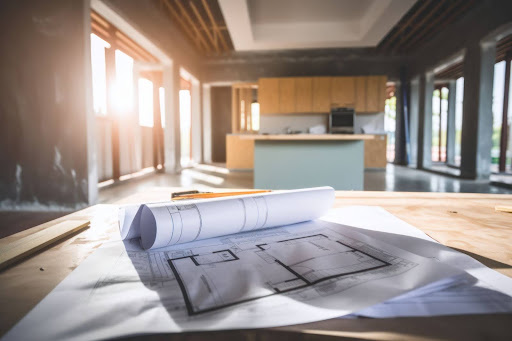Financial Planning for a Major Remodel
Turning your current house into your dream home is an exciting journey that can involve remodeling to align your living space with your vision. The key to successfully achieving this transformation lies in effective financial planning. A well-structured remodel budget is essential for bringing your dream home to life without overextending your finances.
In this guide, we’ll explore the importance of meticulous financial planning in remodeling, from understanding the costs of transforming your space to setting a realistic budget and exploring financing options. We’ll provide you with the tools and knowledge needed to navigate the financial aspects of remodeling, ensuring that your journey to your dream home is as smooth and stress-free as possible.
Let’s embark on this path together, with the right balance of aspiration and financial wisdom, to create the home you’ve always desired.

Understanding the cost of remodeling
Understanding the costs of a major home remodel is the first step in transforming your living space. You need a clear breakdown of expenses to ensure your project aligns with your financial expectations and capabilities.
Typical costs in major home remodels
The costs of remodeling vary widely based on several factors. Generally, these expenses are categorized into materials; labor, design, and engineering fees; permits; and possibly costs for temporary relocation if the remodel is extensive. Material costs fluctuate depending on the quality and type chosen. On the other hand, the complexity of the project and the expertise required will affect labor costs.
Factors influencing the overall cost
- Size of the home: Larger homes or projects involving significant structural changes will incur higher costs due to the increased amount of materials and labor required.
- Quality of materials: High-end materials like natural stone countertops or hardwood flooring will usually increase the budget. Conversely, opting for more cost-effective materials helps manage expenses.
- Labor costs: The scope of the project and the number of professionals needed will affect labor costs. In addition, specialized work, such as electrical or plumbing, typically costs more due to the expertise required.
- Additional factors: Other elements that affect the cost include the age of your home, regional cost differences, and any unforeseen issues like structural damage or mold.
Importance of accurate estimates and quotes
Getting accurate estimates and quotes is vital for budget planning. Seek detailed quotes from multiple contractors to ensure competitive pricing and clarity on what a renovation package includes. A detailed quote should break down the costs of materials, labor, and any other expenses, helping you avoid unexpected costs during the project.
Remember, the lowest quote isn’t always the best — consider the contractor’s reputation, experience, and the quality of their previous work.
A thorough understanding of the costs of a major home remodel is essential for effective budgeting and planning. Consider the various factors that influence these costs and obtain accurate estimates to embark on your remodeling journey with confidence and clarity.
Setting a realistic remodel budget
Setting a realistic budget is a critical step for your dream home remodel. A well-planned budget guides your project and ensures that your vision is achievable without financial strain. Here’s how to set a budget that aligns with your remodeling goals:
Assess your financial situation
Begin by evaluating your current financial status. Consider your savings, income, and any other financial resources you will allocate to the remodel. It’s important to be honest and realistic about what you are able to afford without compromising other financial obligations.
Get detailed estimates
Once you have a clear idea of your financial capacity, start gathering estimates for the work you want to be done. Reach out to contractors for detailed quotes, and remember to include costs for materials, labor, permits, and any other associated expenses. It’s always better to overestimate than underestimate.
Prioritize your projects
With your estimates in hand, prioritize the projects based on your needs and budget. Focus on renovations that add the most value to your home and enhance your quality of life. For instance, updating a kitchen or bathroom may take precedence over cosmetic changes in living spaces.
Allocate funds wisely
Allocate your budget across different aspects of the remodel. Set aside a contingency fund for unexpected expenses (typically 10-20% of your total budget). Unforeseen issues often arise during remodeling, and having a contingency fund ensures these don’t derail your project.
Plan for phases
If your dream remodel exceeds your current budget, consider phasing the project. Tackle the most urgent or valuable renovations first and plan for others over time. This approach allows you to spread out the expenses and avoid overextending financially.
Remember, a realistic remodeling budget is the backbone of a successful home transformation. It requires careful planning, prioritization, and a bit of flexibility.

Financing your remodel: exploring options
Financing your remodel is a crucial aspect of the journey towards creating your dream home. Understanding the various financing options available and their respective pros and cons will help you make an informed decision that aligns with your financial situation.
Savings
Using your savings is the most straightforward financing option, as it doesn’t involve borrowing or paying interest. The major advantage is that it keeps you debt-free. However, depleting your savings leaves you without a financial cushion for emergencies. Consider having a savings account set aside for the remodel and a separate account for emergencies.
Home equity loans
These loans allow you to borrow against the equity you’ve built up in your home. They often come with lower interest rates compared to personal loans and provide a substantial sum. The downside is that your home becomes collateral, meaning you risk foreclosure if you can’t make payments.
Personal loans
Personal loans are a flexible option as they don’t require collateral. They are suitable for those who don’t have much equity in their home or prefer not to use their home as collateral. However, they usually have higher interest rates and shorter repayment terms than home equity loans.
Refinancing
Refinancing your mortgage provides you with a lump sum or lowers your monthly payments, freeing up cash for your remodel. This option is more advantageous if you secure a lower interest rate. However, refinancing extends the life of your mortgage and might come with closing costs.
Choosing the best financing option
Selecting the best financing option depends on several factors, including the amount of money needed, your credit score, your home’s equity, and your comfort level with debt. Consider the long-term implications of each option. Assess the interest rates, repayment terms, and potential impact on your financial stability. Consult with a financial advisor who will provide personalized guidance based on your circumstances.
Ultimately, the right financing option for your remodel should align with your financial goals and situation.

Cost-saving strategies for remodeling your home
Employ several cost-saving strategies to reduce expenses without compromising on quality. Here are some effective tips to keep your remodel budget-friendly:
Try DIY projects
Tackling some aspects of the remodel yourself helps cut costs. Many homeowners undertake simple tasks like painting, installing fixtures, or even basic tiling without professional help. However, you should be realistic about your skills and the time commitment required.
Choose cost-effective materials
A smart way to save is to opt for materials that offer durability and aesthetic appeal without a hefty price tag. For instance, consider laminate countertops that mimic the look of natural stone or luxury vinyl tile as an alternative to hardwood flooring. Research and compare different materials to find the best balance between cost, appearance, and longevity.
Negotiate with contractors and suppliers
Don’t hesitate to negotiate prices with contractors and suppliers. Get multiple quotes to ensure competitive pricing and discuss options for reducing costs. Sometimes, contractors will suggest more affordable alternatives or adjustments to the project that lower the price without sacrificing quality.
Time your remodel for seasonal discounts
The season or time of year is a little-known factor that affects remodeling costs. Typically, demand for contractors is lower during late fall and winter, which sometimes leads to lower prices. Additionally, many home improvement stores offer discounts on materials during certain times of the year, like holiday sales or end-of-season clearances.
By employing these strategies, your dream home remodel becomes more affordable. Remember, careful planning, a willingness to negotiate, and a bit of flexibility go a long way in stretching your remodeling budget.
Long-term financial considerations
When planning a major remodel, consider both the immediate costs and the long-term financial implications. A remodel impacts your home’s insurance, value, property taxes, and future maintenance costs. Understanding these aspects helps you make informed decisions that align with your long-term financial goals.
Impact on home’s value
A well-executed remodel substantially increases your home’s market value, especially if it enhances key areas like the kitchen or bathroom or adds usable living space. However, make sure that your investment aligns with the value of homes in your neighborhood. Over-improving your home beyond the standard in your area might not yield a proportional increase in its market value.
Insurance and property taxes
Post-remodel, your home’s increased value may lead to higher property taxes and insurance premiums. Inform your insurance company of any significant changes to ensure your policy adequately covers your home’s new value. Similarly, be prepared for a possible reassessment of your property’s value, which could affect your tax obligations.
Planning for maintenance and upkeep costs
Every remodel comes with ongoing maintenance and upkeep costs. High-end finishes and modern appliances might require specialized care or servicing. Additionally, larger spaces or added features like a deck or a swimming pool will incur higher long-term maintenance costs. Budgeting for these future expenses helps you avoid financial strain down the line.
While a major remodel transforms your living space and adds value to your home, it’s important to consider the long-term financial implications. Balancing your immediate remodeling desires with future costs and benefits will ensure that your investment is both rewarding and financially sustainable in the long run.

Staying on track: budget management during the remodel
Managing your budget effectively during a remodel is crucial to ensure your project stays on track without unwelcome financial surprises. Here are some things to consider or look out for when planning a remodel budget.
Tools and techniques for budget tracking
Utilize budget tracking tools to keep a close eye on your expenses. Consider using budgeting software or apps specifically designed for home remodeling projects. These tools help you categorize expenses, track invoices, and monitor overall spending against your initial budget. Regularly updating and reviewing this information will give you a clear picture of your financial status at any point in the remodel.
Dealing with budget overruns
Despite careful planning, budget overruns sometimes happen. Have a contingency fund (as previously mentioned) to manage these situations. If you find yourself exceeding the budget, review your project priorities. Identify areas where you might cut back without compromising the overall quality and outcome of the remodel. Sometimes, this means postponing less critical tasks or finding cost-effective alternatives for materials or finishes.
Communication with contractors and suppliers
Effective communication with your contractors and suppliers is key to ensuring budget adherence. Be transparent about your budget constraints from the start and regularly discuss financial matters throughout the project. If unexpected costs arise, work with your contractor to find solutions that align with your budget. Clear and consistent communication will help avoid misunderstandings and ensure everyone is on the same page.
Staying on top of your budget during a remodel requires diligence, flexibility, and open communication. By actively managing your finances, utilizing the right tools, and maintaining a strong partnership with your contractors, you can navigate the financial aspects of your remodel successfully and bring your dream home to life.
Create your dream home with Renovate Ease
Transforming your house into your dream home is an exciting but intricate journey, requiring careful financial planning and strategic decision-making.
At Renovate Ease, we pride ourselves on being a detail-oriented renovation company that places customer service, reasonable timelines, and quality of work at the forefront of everything we do. Our team is dedicated to turning your vision into reality. If you’re ready to remodel your home, Renovate Ease is here to guide you every step of the way.
Contact Renovate Ease today to start crafting the home of your dreams with a team that puts your satisfaction first.

